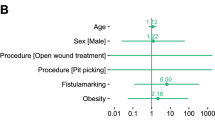Abstract
Pilonidal sinus disease (PSD) is common in adults, but it may also develop in adolescents. The intergluteal groove is a deep moist area in which broken hairs and foreign bodies can collect, often leading to infection. Only a few papers have been published considering PSD in children. For the present study, we retrospectively examined the data of operated patients with PSD. From that review, it appears that high body mass index (BMI) might be a risk factor for the development of PSD and its complications in older children. Fourteen young patients (12 males, 2 females, 12–18 years of age) underwent surgery for PSD. According to the BMI-for-age, eight of these patients (57, 1%) were overweight or obese. Five of them (35.8%) developed mild to moderate postoperative complications. Symptoms recurred in one patient (7.1%) whose BMI was considered as overweight. In patients with normal weight no early or late complications developed. Our findings suggest that high BMI in adolescents is a significant risk factor in the development of both symptoms and complications of PSD after surgical treatment.
Similar content being viewed by others
References
S Yucesan H Dindar I Olcay et al. (1993) ArticleTitlePrevalence of congenital abnormalities in Turkish school children Eur. J. Epidemiol. 9 373–380 Occurrence Handle10.1007/BF00157393 Occurrence Handle8243591
A Çubukçu NN Gönüllü M Paksoy et al. (2000) ArticleTitleThe role of obesity on the recurrence of pilonidal sinus disease in patients, who were treated by excision Int. J. Colorectal Dis. 15 173–175 Occurrence Handle10.1007/s003840000212 Occurrence Handle10954190
M Sakr H El-Hammadi M Moussa et al. (2003) ArticleTitleThe effect of obesity on the results of Karydakis technique for the management of chronic pilonidal sinus Int. J. Colorectal Dis. 18 36–39 Occurrence Handle10.1007/s00384-002-0407-6 Occurrence Handle12458379
TG Allen-Mersh (1990) ArticleTitlePilonidal sinus: finding the right track for treatment Br. J. Surg. 77 123–132 Occurrence Handle2180534
LD Hammer HC Kraemer DM Wilson et al. (1991) ArticleTitleStandardized percentile curves of body-mass index for children and adolescents Am. J. Dis. Child. 145 259–263 Occurrence Handle1750869
F Serour E Somekh B Krutman et al. (2002) ArticleTitleExcision with primary closure and suction drainage for pilonidal sinus in adolescent patients Pediatr. Surg. Int. 18 159–161 Occurrence Handle10.1007/s003830100683 Occurrence Handle11956785
ES Golladay CW Wagner (1990) ArticleTitlePediatric pilonidal disease: a method of management South Med, J. 83 922–924
I Brook KD Anderson G Controni et al. (1980) ArticleTitleAerobic and anaerobic bacteriology of pilonidal cyst abscess in children Am. J. Dis. Child. 134 679–680 Occurrence Handle7395830
RM. Hodges (1880) ArticleTitlePilonidal sinus Boston Med. Surg. J. 103 485–586
K Sondenaa E Andersen I Nesvik et al. (1995) ArticleTitlePatient characteristics and symptoms in chronic pilonidal sinus disease Int. J. Colorectal Dis. 10 39–42 Occurrence Handle10.1007/BF00337585 Occurrence Handle7745322
ML Price WAD Griffiths (1985) ArticleTitleNormal body hair: a review Clin. Exp. Dermatol 10 87–97 Occurrence Handle3884194
JU Baskom (1983) ArticleTitlePilonidal disease: long-term results of follicle removal Dis, Colon Rectum 26 800–807
GE Karydakis (1992) ArticleTitleEasy and successful treatment of pilonidal sinus after explanation of its causative process Aust. N. Z. J. Surg. 62 285–289
JH Armstrong PJ Barcia (1994) ArticleTitlePilonidal sinus disease, conservative approach Arch. Surg. 129 914–917 Occurrence Handle8080372
M Sakr H El-Hammadi M Moussa et al. (2003) ArticleTitleThe effect of obesity on the results of Karydakis technique for the management of chronic pilonidal sinus Int. J. Colorectal Dis. 18 36–39 Occurrence Handle10.1007/s00384-002-0407-6 Occurrence Handle12458379
Author information
Authors and Affiliations
Corresponding author
Rights and permissions
About this article
Cite this article
Arda, İ.S., Güney, L.H., Sevmiş, Ş. et al. High Body Mass Index as a Possible Risk Factor for Pilonidal Sinus Disease in Adolescents . World J. Surg. 29, 469–471 (2005). https://doi.org/10.1007/s00268-004-7533-y
Published:
Issue Date:
DOI: https://doi.org/10.1007/s00268-004-7533-y



